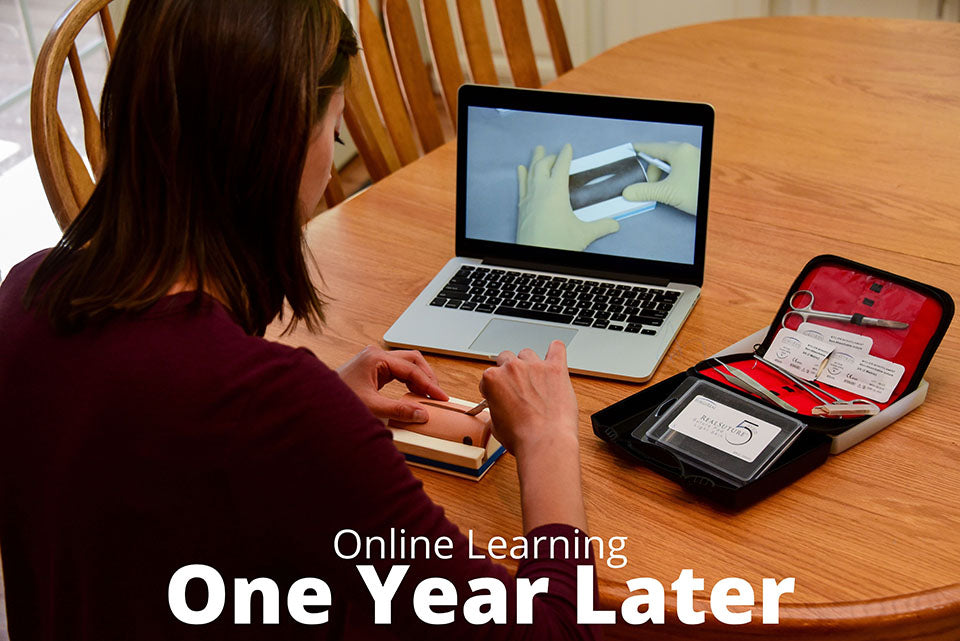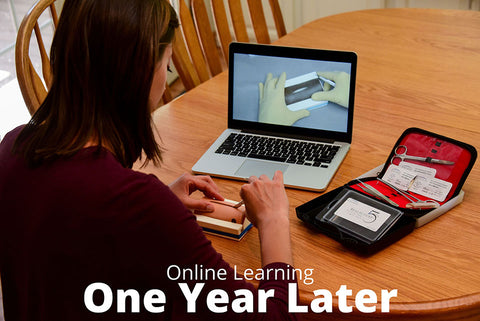

To learn more about our RealSuture 6-Layer Suture Pad click here.
Over a year into the COVID-19 pandemic, we’ve learned that virtual suture training really does work. Last fall, we shared resources and thoughts on How to Provide Suture Training in a Virtual Setting. While in-person training remains the gold-standard, instructors and practitioners have honed their online teaching skills over the last year. To successfully support remote learners as they develop suturing and other technical skills, instructors can focus on incorporating quality training videos into their curriculum, ensuring students have durable, high-fidelity practice materials, and providing targeted feedback.
Training videos
Training videos are a tried-and-true method of supplementing instruction. In many technical fields, students find value in a demonstration that can be rewound, slowed down, and paused. In fact, watching a video on a skill before attempting it can increase retention and success even when practice is in-person, making this a valuable takeaway even after pandemic conditions have ended [1].
With suture training, students need videos that are shot with slow movements to clearly demonstrate how each step of the process works. That said, there is no need to reinvent the wheel or suddenly pivot to video production! Using pre-made training videos that follow best practices will free up time for you to focus on connecting with your students. At SurgiReal, we have an entire library of videos that can be incorporated into your instruction. These cover the basics of how to suture and how to perform specialized procedures.
As an added benefit, videos make it possible to highlight different techniques for the same skill. This allows students to experiment and choose the technique that best suits their movements. For example, SurgiReal has four One Hand Knot Tie videos. These demonstrate two different variants for both right and left hand dominant learners. Use a range of videos such as these to frame and support your instruction while still providing students with flexibility.
Quality practice tools
Research demonstrates that low-stress practice is a crucial component of learning and retaining suturing skills [2]. After watching a training video, students need appropriate models on which to practice these new skills. Ideally, these models are designed to effectively teach the desired skill, as low-quality models can lead to bad habits. Models should also be re-usable, as students need to practice suturing procedures consistently and over an extended period of time in order to achieve proficiency [3]. After that, regular practice is critical to maintain those skills. SurgiReal’s suture pads meet and exceed these specifications. Our suture pads have up to 6 distinct layers, which allow students to practice a wide range of procedures in a material that reacts realistically. Students who rely on lower-quality materials, such as pigs’ feet, run the risk of learning and repetitively practicing poor habits that will need to be re-trained when they begin to work with patients.
Set the scene for quality feedback
The most important step in ensuring that remote learners develop strong suturing skills is detailed, targeted instructor feedback [4]. In order to accomplish this, both the student and instructor need to do a bit of preparation. On both ends, a good internet connection is absolutely necessary for recording and sharing student practice, especially if the instructor will be observing student work live. A document camera or other device that can be mounted allows instructors to observe student work from a first-person vantage. Students should also pay attention to lighting; inadequate lighting over their shoulder will make it next to impossible for an instructor to see their work. On the instructor’s side, software that allows the instructor to narrate their feedback over students’ demonstration video is incredibly valuable, as students can see exactly what instructors are referring to and review those comments as they occur.
Ease Anxiety
As a final note, students are more stressed than ever during this pandemic. In addition to juggling high-stakes course work, they may be living and working in environments that are not conducive to concentration and study. Stress and anxiety can make learning incredibly difficult. Relying on recorded training videos that students can access at any time goes a long way in easing that stress.
Another way instructors can help relieve anxiety is to encourage students to reach for tools and materials that are already packaged together and ready to go. SurgiReal’s suture training kits contain everything students need: a suture pad, scalpel, forceps, stitch scissor, and needle holder. Starting with one of our kits ensures students do not need to waste valuable practice time seeking out separate tools and pads. Everything is already together and easily accessible in one place.
A year of virtual suture training has made it clear that with adequate preparation, materials, and support, students can confidently learn suturing skills remotely.
To learn more about our RealSuture 6-Layer Suture Pad click here.
References
- Chiu H-Y, Kang Y-N, Wang W-L, et al. The Effectiveness of a Simulation-Based Flipped Classroom in the Acquisition of Laparoscopic Suturing Skills in Medical Students—A Pilot Study. J Surg Educ. 2018;75(2):326-332. doi:10.1016/j.jsurg.2017.07.007
- Manning EP, Mishall PL, Weidmann MD, et al. Early and prolonged opportunities to practice suturing increases medical student comfort with suturing during clerkships: Suturing during cadaver dissection. Anat Sci Educ. 2018;11(6):605-612. doi:10.1002/ase.1785
- Routt, E., Mansouri, Y., de Moll, EH., Bernstein, DM., Bernardo, SG. & Levitt, J. Teaching the Simple Suture to Medical Students for Long-term Retention of Skill. JAMA Dermatol. 2015;151(7): 761–765. doi:10.1001/jamadermatol.2015.118
- Naik ND, Abbott EF, Gas BL, Murphy BL, Farley DR, Cook DA. Personalized video feedback improves suturing skills of incoming general surgery trainees. Surgery. 2018;163(4):921-926. doi:10.1016/j.surg.2017.11.006
